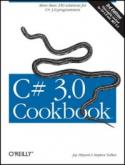 Completely updated for C# 3.0 and the .NET 3.5
platform, the new edition of this bestseller offers more than 250 code
recipes to common and not-so-common problems that C# programmers face
every day. Every recipe in the book has been reconsidered with more
than a third of them rewritten to take advantage of new C# 3.0
features. If you prefer solutions you can use today to general C#
language instruction, and quick answers to theory, this is your book.
C# 3.0 Cookbook offers a new chapter on LINQ (language integrated
query), plus two expanded chapters for recipes for extension methods,
lambda functions, object initializers, new synchronization primitives
and more. The new edition is also complemented by a public wiki, which
not only includes all of the C# 2.0 recipes from the previous edition
unchanged by the release of C# 3.0, but invites you to suggest better
ways to solve those tasks. Here are some of topics covered: LINQ
Numeric data types and Enumerations Strings and characters Classes and
structures Generics Collections Exception handling Delegates, events,
and lambda expressions Filesystem interactions Web site access XML
usage (including LINQ to XML, XPath and XSLT) Networking Threading Data
Structures & Algorithms Each recipe in the book includes tested
code that you can download from oreilly.com and reuse in your own
applications, and each one includes a detailed discussion of how and
why the underling technology works. You don't have to be an experienced
C# or .NET developer to use C# 3.0 Cookbook. You just have to be
someone who wants to solve a problem now, without having to learn all
the related theory first.
Completely updated for C# 3.0 and the .NET 3.5
platform, the new edition of this bestseller offers more than 250 code
recipes to common and not-so-common problems that C# programmers face
every day. Every recipe in the book has been reconsidered with more
than a third of them rewritten to take advantage of new C# 3.0
features. If you prefer solutions you can use today to general C#
language instruction, and quick answers to theory, this is your book.
C# 3.0 Cookbook offers a new chapter on LINQ (language integrated
query), plus two expanded chapters for recipes for extension methods,
lambda functions, object initializers, new synchronization primitives
and more. The new edition is also complemented by a public wiki, which
not only includes all of the C# 2.0 recipes from the previous edition
unchanged by the release of C# 3.0, but invites you to suggest better
ways to solve those tasks. Here are some of topics covered: LINQ
Numeric data types and Enumerations Strings and characters Classes and
structures Generics Collections Exception handling Delegates, events,
and lambda expressions Filesystem interactions Web site access XML
usage (including LINQ to XML, XPath and XSLT) Networking Threading Data
Structures & Algorithms Each recipe in the book includes tested
code that you can download from oreilly.com and reuse in your own
applications, and each one includes a detailed discussion of how and
why the underling technology works. You don't have to be an experienced
C# or .NET developer to use C# 3.0 Cookbook. You just have to be
someone who wants to solve a problem now, without having to learn all
the related theory first.
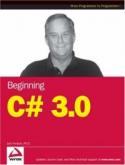 Beginning C# is a book that offers a lot of guidance, in a
format that readers find intuitive to follow. The exercise-based format
of the Wrox Beginning series has a strong following by all levels of
readers, and is one that works very well in the classroom or home.
Written by a veteran programming instructor, this is the perfect mix of
tutorial, and hands-on coding new programmers are looking for - written
from their point of view.
Beginning C# is a book that offers a lot of guidance, in a
format that readers find intuitive to follow. The exercise-based format
of the Wrox Beginning series has a strong following by all levels of
readers, and is one that works very well in the classroom or home.
Written by a veteran programming instructor, this is the perfect mix of
tutorial, and hands-on coding new programmers are looking for - written
from their point of view.
Beginning C# is written for those readers with no prior programming experience who want a thorough, yet easy to understand, introduction to C# and Object Oriented Programming.
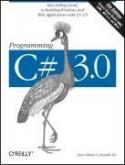 Written by popular author and .NET expert Jesse Liberty, this
thoroughly updated tutorial for beginning to intermediate programmers
covers the latest release of Microsoft's popular C# language (C# 3.0)
and the newest .NET platform for developing Windows and web
applications. Our bestselling Programming C# 3.0, now in its fifth
edition, is a world-class tutorial that goes well beyond the
documentation otherwise available. Liberty doesn't just teach C#; he
tells the complete story of the C# language and how it integrates with
all of .NET programming, so that you can get started creating
professional quality web and Windows applications. This book: Provides
a comprehensive tutorial in C# and .NET programming that also serves as
a useful reference you'll want by your side while you're working Covers
all of the new features of the language, thoroughly integrated into
every chapter, rather than tacked on at the end Provides insight into
best practices and insight into real world programming by a
professional programmer who worked with C# as an independent contractor
for nearly a decade before joining Microsoft as a Senior Program
Manager Every chapter in this book has been totally revised, and the
entire book has been reorganized to respond to the significant changes
in the language Full coverage, from the ground up of LINQ (Language
Integrated Query) and other C# 3.0 language innovations to speed up
development tasks Explains how to use C# in creating Web Applications
as well as Windows Applications, using both the new Windows
Presentation Foundation (WPF) and the older WinForms technology This
new edition of Programming C# 3.0 is for working programmers who want
to develop proficiency inMicrosoft's most important language. No prior
.NET experience is required for you to get started. There's no time
like the present to work with C# -- and no book like this one to teach
you everything you need to know. Special note to VB6 and Java
programmers: if you've decided to transition to .NET, this book will
take you there.
Written by popular author and .NET expert Jesse Liberty, this
thoroughly updated tutorial for beginning to intermediate programmers
covers the latest release of Microsoft's popular C# language (C# 3.0)
and the newest .NET platform for developing Windows and web
applications. Our bestselling Programming C# 3.0, now in its fifth
edition, is a world-class tutorial that goes well beyond the
documentation otherwise available. Liberty doesn't just teach C#; he
tells the complete story of the C# language and how it integrates with
all of .NET programming, so that you can get started creating
professional quality web and Windows applications. This book: Provides
a comprehensive tutorial in C# and .NET programming that also serves as
a useful reference you'll want by your side while you're working Covers
all of the new features of the language, thoroughly integrated into
every chapter, rather than tacked on at the end Provides insight into
best practices and insight into real world programming by a
professional programmer who worked with C# as an independent contractor
for nearly a decade before joining Microsoft as a Senior Program
Manager Every chapter in this book has been totally revised, and the
entire book has been reorganized to respond to the significant changes
in the language Full coverage, from the ground up of LINQ (Language
Integrated Query) and other C# 3.0 language innovations to speed up
development tasks Explains how to use C# in creating Web Applications
as well as Windows Applications, using both the new Windows
Presentation Foundation (WPF) and the older WinForms technology This
new edition of Programming C# 3.0 is for working programmers who want
to develop proficiency inMicrosoft's most important language. No prior
.NET experience is required for you to get started. There's no time
like the present to work with C# -- and no book like this one to teach
you everything you need to know. Special note to VB6 and Java
programmers: if you've decided to transition to .NET, this book will
take you there.
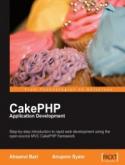 Cake is a rapid development framework for PHP that uses
well-known design patterns and provides a structured framework that
enables PHP users at all levels to rapidly develop robust web
applications, without any loss of flexibility. It means you can code
faster, your code is better, and it makes writing Web 2.0-style apps a
snap.
Cake is a rapid development framework for PHP that uses
well-known design patterns and provides a structured framework that
enables PHP users at all levels to rapidly develop robust web
applications, without any loss of flexibility. It means you can code
faster, your code is better, and it makes writing Web 2.0-style apps a
snap.This book builds on your knowledge as a PHP developer to provide a fast-paced, step-by-step tutorial in building CakePHP applications. The book is packed with example code and demo applications, so that you can see techniques in action.
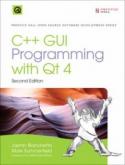 The Only Official, Best-Practice Guide to Qt 4.3 Programming
The Only Official, Best-Practice Guide to Qt 4.3 Programming
Using Trolltech's Qt you can build industrial-strength C++ applications that run natively on Windows, Linux/Unix, Mac OS X, and embedded Linux without source code changes. Now, two Trolltech insiders have written a start-to-finish guide to getting outstanding results with the latest version of Qt: Qt 4.3.
Packed with realistic examples and in-depth advice, this is the book Trolltech uses to teach Qt to its own new hires. Extensively revised and expanded, it reveals today's best Qt programming patterns for everything from implementing model/view architecture to using Qt 4.3's improved graphics support. You'll find proven solutions for virtually every GUI development task, as well as sophisticated techniques for providing database access, integrating XML, using subclassing, composition, and more. Whether you're new to Qt or upgrading from an older version, this book can help you accomplish everything that Qt 4.3 makes possible.
- Completely updated throughout, with significant new coverage of databases, XML, and Qtopia embedded programming
- Covers all Qt 4.2/4.3 changes, including Windows Vista support, native CSS support for widget styling, and SVG file generation
- Contains separate 2D and 3D chapters, coverage of Qt 4.3's new graphics view classes, and an introduction to QPainter's OpenGL back-end
- Includes new chapters on look-and-feel customization and application scripting
- Illustrates Qt 4's model/view architecture, plugin support, layout management, event processing, container classes, and much more
- Presents advanced techniques covered in no other book–from creating plugins to interfacing with native APIs
- Includes a new appendix on Qt Jambi, the new Java version of Qt
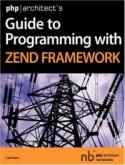 Learn to master the secrets of the Zend Framework with this new book
from php|architect's popular Nanobook series! Written by Zend DevZone
editor and well-known PHP expert Cal Evans, php|architect's Guide to
Programming with Zend Framework helps you understand the Zend Framework
through a detailed roadmap into its features and functionality. This
book covers much of the primary functionality offered by the Zend
Framework, and works well both as a thorough introduction to its use
and as a reference for higher-level tasks. The table of contents
includes: - Getting started - The Model - The Controller - The View -
Data access - Web services - Authorizations - Exceptions and error
management - Rich Internet Applications - Hacking the framework: secret
classes and advanced functionality - Framework internals - Tips &
tricks - The new Zend_Layout classes With a rich, example-driven style
and the trademark no-fluff approach to professional content,
php|architect's Guide to Programming with the Zend Framework belongs in
your book collection!
Learn to master the secrets of the Zend Framework with this new book
from php|architect's popular Nanobook series! Written by Zend DevZone
editor and well-known PHP expert Cal Evans, php|architect's Guide to
Programming with Zend Framework helps you understand the Zend Framework
through a detailed roadmap into its features and functionality. This
book covers much of the primary functionality offered by the Zend
Framework, and works well both as a thorough introduction to its use
and as a reference for higher-level tasks. The table of contents
includes: - Getting started - The Model - The Controller - The View -
Data access - Web services - Authorizations - Exceptions and error
management - Rich Internet Applications - Hacking the framework: secret
classes and advanced functionality - Framework internals - Tips &
tricks - The new Zend_Layout classes With a rich, example-driven style
and the trademark no-fluff approach to professional content,
php|architect's Guide to Programming with the Zend Framework belongs in
your book collection!
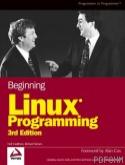 If you have some programming experience and are ready to venture into
Linux programming, this updated edition of the bestselling entry-level
book takes you there. New to this edition are chapters on MySQL® access and administration; programming GNOMETM and KDETM;
and Linux standards for portable applications. Coverage of kernel
programming, device drivers, CVS, grep, and GUI development
environments has expanded.
If you have some programming experience and are ready to venture into
Linux programming, this updated edition of the bestselling entry-level
book takes you there. New to this edition are chapters on MySQL® access and administration; programming GNOMETM and KDETM;
and Linux standards for portable applications. Coverage of kernel
programming, device drivers, CVS, grep, and GUI development
environments has expanded.
The authors guide you step by step, using construction of a CD database application to give you hands-on experience as you progress from the basic to the complex.
You’ll start with fundamental concepts like writing Linux programs in C. You’ll learn basic system calls, file I/O, interprocess communication, and shell programming. You’ll become skilled with the toolkits and libraries for working with user interfaces. The book starts with the basics, explaining how to compile and run your first program. First, each concept is explained to give you a solid understanding of the material. Practical examples are then presented, so you see how to apply the knowledge in real applications.
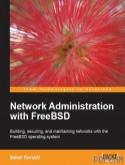 This book is a guide to FreeBSD for network administrators; therefore
it does not cover basic installation and configuration of FreeBSD, but
is about using FreeBSD to build, secure, and maintain networks. After
introducing the basic tools for monitoring the performance and security
of the system the book moves on to cover using jails-FreeBSD virtual
environments-to secure your network. Then it shows how to overcome the
different bottlenecks that you may meet depending on the services you
are running by tweaking different parameters to maintain a high
performance from your FreeBSD server. Next it covers using the ifconfig
utility to configure interfaces with different layer protocols and
about connectivity testing and debugging tools. After covering using
User PPP or Kernel PPP for Point-to-Point Protocol network
configuration it explains basic IP forwarding in FreeBSD and the use of
the built-in routing daemons, routed and route6d, which support RIPv1,
RIPv2, RIPng, and RDISC. Next it covers the OpenOSPFD and OpenBGPD
daemons that you can install to run OSPF and BGP on your host. Then it
covers setup and configuration of IPFW and PF, and finally looks at
some important internet services and how to set them up on your FreeBSD
server
This book is a guide to FreeBSD for network administrators; therefore
it does not cover basic installation and configuration of FreeBSD, but
is about using FreeBSD to build, secure, and maintain networks. After
introducing the basic tools for monitoring the performance and security
of the system the book moves on to cover using jails-FreeBSD virtual
environments-to secure your network. Then it shows how to overcome the
different bottlenecks that you may meet depending on the services you
are running by tweaking different parameters to maintain a high
performance from your FreeBSD server. Next it covers using the ifconfig
utility to configure interfaces with different layer protocols and
about connectivity testing and debugging tools. After covering using
User PPP or Kernel PPP for Point-to-Point Protocol network
configuration it explains basic IP forwarding in FreeBSD and the use of
the built-in routing daemons, routed and route6d, which support RIPv1,
RIPv2, RIPng, and RDISC. Next it covers the OpenOSPFD and OpenBGPD
daemons that you can install to run OSPF and BGP on your host. Then it
covers setup and configuration of IPFW and PF, and finally looks at
some important internet services and how to set them up on your FreeBSD
server
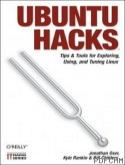 The Ubuntu distribution simplifies Linux by
providing a sensible collection of applications, an easy-to-use package
manager, and lots of fine-tuning, which make it possibly the best Linux
for desktops and laptops. Readers of both Linux Journal and TUX Magazine
confirmed this by voting Ubuntu as the best Linux distribution in each
publication's 2005 Readers Choice Awards. None of that simplification,
however, makes Ubuntu any less fun if you're a hacker or a power user.
The Ubuntu distribution simplifies Linux by
providing a sensible collection of applications, an easy-to-use package
manager, and lots of fine-tuning, which make it possibly the best Linux
for desktops and laptops. Readers of both Linux Journal and TUX Magazine
confirmed this by voting Ubuntu as the best Linux distribution in each
publication's 2005 Readers Choice Awards. None of that simplification,
however, makes Ubuntu any less fun if you're a hacker or a power user.Like all books in the "Hacks" series,Ubuntu Hacks includes 100 quick tips and tricks for all users of all technical levels. Beginners will appreciate the installation advice and tips on getting the most out of the free applications packaged with Ubuntu, while intermediate and advanced readers will learn the ins-and-outs of power management, wireless roaming, 3D video acceleration, server configuration, and much more.
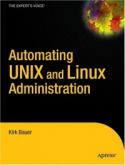 Wouldn’t you like to automate the tedious daily tasks of system administration? Automating UNIX and Linux Administration
will show you how, by exploring existing tools and offering real-world
examples. Parts of the book are Linux-specific, but most of it applies
to a UNIX system, including multiple variants of UNIX. Author Kirk
Bauer briefly overviews tools and technologies—and assumes preliminary
knowledge about editing a configuration file or mounting a file system.
Wouldn’t you like to automate the tedious daily tasks of system administration? Automating UNIX and Linux Administration
will show you how, by exploring existing tools and offering real-world
examples. Parts of the book are Linux-specific, but most of it applies
to a UNIX system, including multiple variants of UNIX. Author Kirk
Bauer briefly overviews tools and technologies—and assumes preliminary
knowledge about editing a configuration file or mounting a file system.
The techniques, methods, and tools in this book will help you manage a single system—but will prove especially powerful across multiple systems. No matter if the systems are desktops, servers, or Beowulf clusters—all of them will benefit from this automation. And managing five to five thousand systems will become a simpler task!
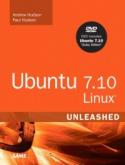 Welcome to Ubuntu 7.10 Linux Unleashed! This book covers the
free Linux distribution named Ubuntu and includes a fully functional
and complete operating system produced by the Ubuntu Community,
sponsored by Canonical Software.
Welcome to Ubuntu 7.10 Linux Unleashed! This book covers the
free Linux distribution named Ubuntu and includes a fully functional
and complete operating system produced by the Ubuntu Community,
sponsored by Canonical Software.Ubuntu directly descends from one of the oldest and most revered Linux distributions ever: Debian. Those of you who know nothing about Linux will likely not have heard of Debian; it is enough to know that it is considered to be one of the most stable and secure Linux distributions currently available. Ubuntu benefits directly from many contributions from free software developers across the world.
If you are new to Linux, you have made a great decision by choosing this book. Sams Publishing’s Unleashed books offer an in-depth look at their subject, taking in both beginner and advanced users and moving them to a new level of knowledge and expertise. Ubuntu is a fast-changing distribution that can be updated at least twice a year. We have tracked the development of Ubuntu from early on to make sure that the information in this book mirrors closely the development of the distribution. A full copy of Ubuntu is included on the enclosed disc, making it possible for you to install Linux in less than an hour! No longer an upstart, Linux now has an enviable position in today’s modern computing world. It can be found on machines as diverse as mobile phones and wristwatches, all the way up to supercomputers—in fact, Linux currently runs on more than half of the world’s top 500 supercomputers.
Do not let the reputation of Linux discourage you, however. Most people who have heard of Linux think that it is found only on servers, looking after websites and email. Nothing could be further from the truth because Linux is making huge inroads in to the desktop market, too. Corporations are realizing the benefits of running a stable and powerful operating system that is easy to maintain and easy to secure. Add to that the hundreds of improvements in usability, and Linux becomes an attractive proposition that tempts many CIOs. The best part is that as large Linux vendors improve Linux, the majority of those improvements make it into freely available distributions, allowing you to benefit from the additions and refinements made. You can put Ubuntu to work today and be assured of a great user experience.
This book provides all the information that you need to get up and running with Ubuntu. It even tells you how to keep Ubuntu running in top shape and how to adapt Ubuntu to changes in your own needs. You can use Ubuntu at home, in the workplace, or, with permission, at your school or college. In fact, you might want to poke around your school’s computer rooms: You will probably find that someone has already beaten you to the punch—Linux is commonly found in academic institutions. Feel free to make as many copies of the software as you want; because Ubuntu is freely distributable all over the world, no copyright lawyers are going to pound on your door.
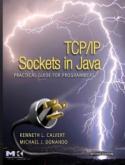 Most Internet applications use sockets to implement network communication protocols. TCP/IP Sockets in Java: Practical Guide for Programmers,
with its focused, tutorial-based coverage, helps you master the tasks
and techniques essential to virtually all client-server projects using
sockets in Java. Later chapters teach you to implement more specialized
functionality; incisive discussions of programming constructs and
protocol implementations equip you with a deeper understanding that is
invaluable for meeting future challenges. No other resource presents so
concisely or so effectively the exact material you need to get up and
running with Java sockets programming right away.
Most Internet applications use sockets to implement network communication protocols. TCP/IP Sockets in Java: Practical Guide for Programmers,
with its focused, tutorial-based coverage, helps you master the tasks
and techniques essential to virtually all client-server projects using
sockets in Java. Later chapters teach you to implement more specialized
functionality; incisive discussions of programming constructs and
protocol implementations equip you with a deeper understanding that is
invaluable for meeting future challenges. No other resource presents so
concisely or so effectively the exact material you need to get up and
running with Java sockets programming right away.For those who program using the C language, be sure to check out this book's companion, TCP/IP Sockets in C: Practical Guide for Programmers.
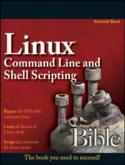 Learn all the command lines for all Linux shells in this one-stop guide
Learn all the command lines for all Linux shells in this one-stop guide
There's a lot to be said for going back to basics. Not only does this Bible give you a quick refresher on the structure of open-source Linux software, it also shows you how to bypass the hefty graphical user interface on Linux systems and start interacting the fast and efficient way—with command lines and automated scripts. You'll learn how to manage files on the filesystem, start and stop programs, use databases, even do Web programming—without a GUI—with this one-stop resource.
- Understand the Linux desktop and various command-line parameters
- Learn filesystem navigation, file handling, and the basics of bash shell commands
- Write shell scripts to automate routine functions and reports
- Harness nesting loops and structured commands
- Monitor programs, master file permissions, and make queries
- Run scripts in background mode and schedule jobs
- Use sed, gawk, and regular expressions
- Explore all alternate shells, including ash, tcsh, ksh, korn, and zsh
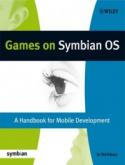 The first part of this book discusses the mobile games industry,
and includes analysis of why the mobile industry differs from other
sectors of the games market, a discussion of the sales of mobile games,
their types, the gamers who play them, and how the games are sold.
The first part of this book discusses the mobile games industry,
and includes analysis of why the mobile industry differs from other
sectors of the games market, a discussion of the sales of mobile games,
their types, the gamers who play them, and how the games are sold.The second part describes key aspects of writing games for Symbian smartphones using Symbian C++ and native APIs. The chapters cover the use of graphics and audio, multiplayer game design, the basics of writing a game loop using Symbian OS active objects, and general good practice. There is also a chapter covering the use of hardware APIs, such as the camera and vibra.
Part Three covers porting games to Symbian OS using C or C++, and discusses the standards support that Symbian OS provides,and some of the middleware solutions available. A chapter about the N-Gage platform discusses how Nokia is pioneering the next generation of mobile games, by providing a platform SDK for professional games developers to port games rapidly and effectively.
The final part of the book discusses how to create mobile games for Symbian smartphones using java ME, Doja (for Japan) or Flash Lite 2. This book will help you if you are:
~ a C++ developer familiar with mobile development but new to the games market
~ a professional games developer wishing to port your games to run on Symbian OS platforms such as S60 and UIQ
~ a someone who is interested in creating C++, Java ME or Flash Lite games for Symbian smartphones.
This book shows how to create mobile games for Symbian smartphones such as S60 3rd Edition, UIQ3 or FOMA devices. It includes contributions from a number of experts in the mobile games industry, including Nokia's N-gage team, Ideaworks3D, and ZingMagic, as well as academics leading the field of innovative mobile experiences.
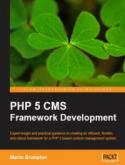 This book guides you through the design and implementation
decisions necessary to create a working architecture for a PHP5-based
content management system. Each of the major areas and decision points
are reviewed and discussed. Code examples, which take advantage of
PHP5's object oriented nature, are provided and explained. They serve
as a means of illustrating the detailed development issues created by a
CMS. In areas where the code is too voluminous to be reproduced in
detail, the design principles are explained along with some critical
pieces of code. A basic knowledge of PHP is assumed.
This book guides you through the design and implementation
decisions necessary to create a working architecture for a PHP5-based
content management system. Each of the major areas and decision points
are reviewed and discussed. Code examples, which take advantage of
PHP5's object oriented nature, are provided and explained. They serve
as a means of illustrating the detailed development issues created by a
CMS. In areas where the code is too voluminous to be reproduced in
detail, the design principles are explained along with some critical
pieces of code. A basic knowledge of PHP is assumed.
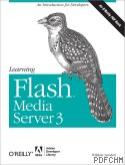
If you're interested in recording and streaming media using Flash Media Server 3 (FMS3) and Adobe's Real-Time Messaging Protocol, this unique 267-page PDF-only book is the perfect primer. It is not a reference, but a systematic guide to developing FMS3 applications using ActionScript 3.0, with chapters that focus on specific aspects of the server and how they work. FMS3 is very different from regular web servers. Because its open-socket server technology stays connected until users quit the application, you can stream audio, video, text, and other media in real time. FMS3 is also quite different from previous versions, a fact that web developers familiar with Flash Media Server 2 or Flash Communication Server 1.5 will quickly discover. Don't worry. With Learning Flash Media Server 3 and a little experience with Flash CS3 and ActionScript 3.0, anyone can get up to speed in no time. You'll learn how to install FMS3, organize your development environment with Apache web server, and use the management console before diving into the whys and hows of:
- Recording and playing back streaming audio and video in VP6 and H.264 formats
- Using the new Flash Media Encoder to stream and record video
- Camera and microphone settings
- Non-persistent client-side remote shared objects
- Two-way audio-video communications
- Broadcasting and server-side bandwidth control
- Working with server-side files: the file class
- Server-side shared objects
- Server-side streams
- Setting up a software load handler using FMS3's new server-side NetStream
- Bringing in data and working with configuration files
At the heart of every chapter is a core set of code that shows the minimum requirements needed for different procedures. Beyond that, Learning Flash Media Server 3 provides you with plenty of options for using FMS3's different versions -- the full-feature server, the streaming-only server, and the limited-user development server. It's a whole new world of media, and this book puts you right at the doorstep. Ready to enter?
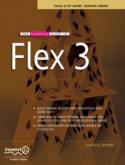 Flex 3 is the next generation of a technology that revolutionized web
applications. It is the next evolutionary step of Flash, which has
grown from a web animation medium to a powerful enterprise web design
and development platform. With nearly 98% of all web browsers, and a
growing number of mobile devices, running Flash Player, a knowledge of
Flex is indispensible for any serious web developer.
Flex 3 is the next generation of a technology that revolutionized web
applications. It is the next evolutionary step of Flash, which has
grown from a web animation medium to a powerful enterprise web design
and development platform. With nearly 98% of all web browsers, and a
growing number of mobile devices, running Flash Player, a knowledge of
Flex is indispensible for any serious web developer.
This book will show you how to create powerful Rich Internet Applications using Flex 3. After learning how to install and becoming familiar with the basics of the Flex Builder 3 software, you will explore in depth how the Flash scripting language, ActionScript 3.0, interacts with Flex's powerful XML-like design language: MXML.
You'll learn how to construct your applications using layout and navigation containers, and how to move between various states using transitions. There is coverage of how best to plan your applications and use the Model-View-Controller pattern to keep various aspects of development separated and ease creation of potentially complicated projects.
Rich Internet Applications rely on data, and this book shows how to bring data from various sources into your Flex application and check its integrity, and how best to display and interact with it.
Going farther, applications built for the Flash platform can now exist and function beyond the traditional confines of the web browser. Adobe AIR allows you to take your applications to the desktop, and this book shows how to reapply your Flex skills to take advantage of this new environment.
The Essential Guide to Flex 3 takes you through all the powerful features of Flex using a series of stand-alone, practical exercises. The skills acquired throughout the book are then brought together in the form of a full-featured case study application showcasing essential techniques that can easily be applied to your own Flex applications.
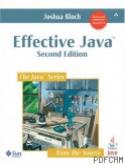 Are you looking for a deeper understanding of the Java™ programming
language so that you can write code that is clearer, more correct, more
robust, and more reusable? Look no further! Effective Java™, Second Edition,
brings together seventy-eight indispensable programmer’s rules of
thumb: working, best-practice solutions for the programming challenges
you encounter every day.
Are you looking for a deeper understanding of the Java™ programming
language so that you can write code that is clearer, more correct, more
robust, and more reusable? Look no further! Effective Java™, Second Edition,
brings together seventy-eight indispensable programmer’s rules of
thumb: working, best-practice solutions for the programming challenges
you encounter every day. This highly anticipated new edition of the
classic, Jolt Award-winning work has been thoroughly updated to cover
Java SE 5 and Java SE 6 features introduced since the first edition.
Bloch explores new design patterns and language idioms, showing you how
to make the most of features ranging from generics to enums,
annotations to autoboxing.
Each chapter in the book consists of several
“items” presented in the form of a short, standalone essay that
provides specific advice, insight into Java platform subtleties, and
outstanding code examples. The comprehensive descriptions and
explanations for each item illuminate what to do, what not to do, and
why.
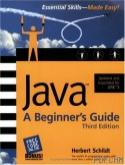
Essential Skills--Made Easy! Updated and Expanded for J2SE 5
Learn to program in Java from master programmer and best-selling author Herb Schildt. Completely revised and updated to cover Java 2 Platform, Standard Edition 5 (J2SEj 5), this step-by-step guide will have you programming in practically no time. You’ll start at the beginning, learning why Java is the preeminent language of the Internet, how it relates to object-oriented programming (OOP), and the general form of a Java program. Next, it’s on to Java fundamentals, including data types, operators, program control statements, classes, objects, and methods. You’ll then progress to more advanced topics, such as inheritance, exception handling, the I/O system, multithreading, and applets. Of course Herb covers the powerful, new features added by J2SE 5, such as generics, autoboxing, enumerations, and static import. Get started programming in Java today with this easy-to-follow tutorial.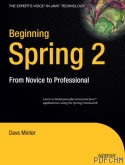 Spring has made a remarkable rise since its conception in 2002. Users
find Spring the ideal framework to build their applications in J2EE
environments. Beginning Spring 2 is the first and only
Spring-authorized book that takes you through the first steps of using
Spring, and requires no prior J2EE experience. It discusses relevant
integrated technologies that you should be aware of, and illustrates
how Spring makes using them easier.
Spring has made a remarkable rise since its conception in 2002. Users
find Spring the ideal framework to build their applications in J2EE
environments. Beginning Spring 2 is the first and only
Spring-authorized book that takes you through the first steps of using
Spring, and requires no prior J2EE experience. It discusses relevant
integrated technologies that you should be aware of, and illustrates
how Spring makes using them easier.
The book teaches the correct usage of Spring in applications, and lowers the learning curve on J2EE standards. It covers useful features of Spring without delving too far into complicated features. The authors take advantage of less complex alternatives whenever possible, and shows how Spring can make you more productive in complicated environments where J2EE technologies need to be applied. The book covers the complete Spring web tools portfolio and deals with persistence and transaction management. It also introduces 3-tier application design and how to test these designs.
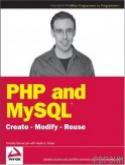 I ’ m especially amazed at how the Internet has grown and evolved over
the past decade or so. It has grown from a collection of static text
documents connected by a few hyperlinks to a platform for delivering
rich, distributed applications. And when it comes time to develop these
web - based applications, many programmers are choosing PHP and MySQL.
I ’ m especially amazed at how the Internet has grown and evolved over
the past decade or so. It has grown from a collection of static text
documents connected by a few hyperlinks to a platform for delivering
rich, distributed applications. And when it comes time to develop these
web - based applications, many programmers are choosing PHP and MySQL.In this book, I present basic code for 12 PHP - powered projects that you can use and extend however you wish. I have tried to write them so the code can be easily reused in future applications, but in some instances the entire application can be reused as well!
I ’ ve enjoyed the opportunity to write and share with you this information and I hope you have just as much fun reading it and learning from it. More importantly, I hope you find good, practical uses for the projects found within this book.
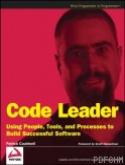
What you will learn from this book
- Practical steps you can take to combine different developmental philosophies, processes, and construction techniques into a unified approach to software
- Methods for deciding which parts of a project you need to write yourself versus what you can buy or reuse
- Tools and processes you can employ to improve source code quality and maintainability
- How to create, run, organize, and measure tests, and then make them more useful to developers and testers
- Ways that programming by contract can make your code easier for developers to understand and use
- Recommended techniques for handling errors in your code that will make your application easier to debug and support
This book is for experienced software developers who are looking to improve their development skill set and bring a higher level of discipline to a project.
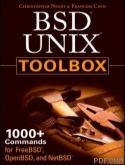
This handy, compact guide teaches you to use BSD UNIX systems as the experts do: from the command line. Try out more than 1,000 commands to find and get software, monitor system health and security, and access network resources. Apply the skills you learn from this book to use and administer servers and desktops running FreeBSD, OpenBSD, NetBSD, or any other BSD flavor.
Expand your BSD UNIX expertise in these and other areas:
- Using the shell
- Finding online software
- Working with files
- Playing with music and images
- Administering file systems
- Backing up data
- Checking and managing running processes
- Accessing network resources
- Handling remote system administration
- Locking down security
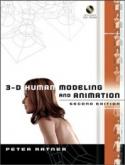 All the tools and know-how to create digital characters that can move, express emotions, and talk
3-D Human Modeling and Animation demonstrates how you can use your
artistic skills in figure drawing, painting, and sculpture to create
animated human figures using the latest computer technology. This
easy-to-follow book guides you through all the necessary steps to
create and animate digital humans. Students and professional 3-D
artists will find this book to be an invaluable resource.
All the tools and know-how to create digital characters that can move, express emotions, and talk
3-D Human Modeling and Animation demonstrates how you can use your
artistic skills in figure drawing, painting, and sculpture to create
animated human figures using the latest computer technology. This
easy-to-follow book guides you through all the necessary steps to
create and animate digital humans. Students and professional 3-D
artists will find this book to be an invaluable resource.
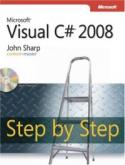 Get the hands-on, step-by-step guide to learning the latest
enhancements in Microsoft Visual C# 2008. Visual C#, one of the tools
in Microsoft Visual Studio 2008, is a modern programming language
designed to deliver a productive environment for creating business
frameworks and reusable object-oriented components. Whether you re a
beginning programmer or new to the Visual C# programming language, you
ll learn how to use the fundamental features of Visual Studio 2008 and
gain a basic understanding of the latest enhancement of the Visual C#
language. You ll work at your own pace through hands-on, learn-by-doing
exercises, get started creating components and working Windows®
applications, and build your knowledge as you start creating your first
Visual C# based applications. You ll also explore how to create data
management and Web-based applications. In each chapter, work through
learn-by-doing exercises that demonstrate how, when, and why to use the
many features of the Visual C# rapid application development
environment.
Get the hands-on, step-by-step guide to learning the latest
enhancements in Microsoft Visual C# 2008. Visual C#, one of the tools
in Microsoft Visual Studio 2008, is a modern programming language
designed to deliver a productive environment for creating business
frameworks and reusable object-oriented components. Whether you re a
beginning programmer or new to the Visual C# programming language, you
ll learn how to use the fundamental features of Visual Studio 2008 and
gain a basic understanding of the latest enhancement of the Visual C#
language. You ll work at your own pace through hands-on, learn-by-doing
exercises, get started creating components and working Windows®
applications, and build your knowledge as you start creating your first
Visual C# based applications. You ll also explore how to create data
management and Web-based applications. In each chapter, work through
learn-by-doing exercises that demonstrate how, when, and why to use the
many features of the Visual C# rapid application development
environment.
 Современный дизайн штор - довольно непростая задача. Здесь надо учесть
многое: геометрию помещения, стиль интерьера, степень освещенности,
цветовую гамму и еще многое и многое другое. Так что лучше доверить
дизайн штор опытным специалистам. Они помогут Вам выбрать материал,
аксессуары, предложат эскиз. Это позволит осуществить индивидуальный
подход, разработать дизайн штор для кухни, гостиной или спальни с
учетом не только особенностей помещения, но и Ваших личных пожеланий.
Современный дизайн штор - довольно непростая задача. Здесь надо учесть
многое: геометрию помещения, стиль интерьера, степень освещенности,
цветовую гамму и еще многое и многое другое. Так что лучше доверить
дизайн штор опытным специалистам. Они помогут Вам выбрать материал,
аксессуары, предложат эскиз. Это позволит осуществить индивидуальный
подход, разработать дизайн штор для кухни, гостиной или спальни с
учетом не только особенностей помещения, но и Ваших личных пожеланий.
 Классические шторы подходят практически любому интерьеру. Это самый популярный вид штор.
Классические шторы подходят практически любому интерьеру. Это самый популярный вид штор.
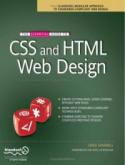 The Essential Guide to CSS and HTML Web Design is a special book—it will tell you all you need
to know to design great web sites that are standards compliant, usable,
and look great, but not overwhelm you with waffle, theory, and obscure
details. It is designed to be invaluable to you, whatever stage you are
at in your career, with a mixture of practical tutorials and reference
material—beginners will quickly pick up the basics, while more
experienced web designers and developers will keep returning to the
book again and again to recap on techniques they maybe haven't used for
a while, or look up properties, attributes and other details. It is
destined to become a close friend, adopting a permanent place on your
desk. It starts off by giving a brief introduction to the internet, and
the broad area of web design, before diving straight in to HTML and CSS
basics, reusing code, other best practices. It then focuses on all the
most important areas of a successful web site—typography, images,
navigation, tables, layouts, forms and feedback (including ready made
PHP scripts for you to use,) and browser quirks, hacks and bugs. The
book is completely up-to-date, covering support of the newest standards
in all the latest browsers, including IE 7 and Firefox 2. The last
chapter of the book provides several case studies for you to dissect
and learn from, including all the most popular web site archetypes—a
blog, a store front, a corporate home page, and an online gallery. Then
the book is rounded off with several detailed reference appendices
covering CSS, HTML, Color references, entities, and more, meaning that
any details you need to look up are close at hand.
The Essential Guide to CSS and HTML Web Design is a special book—it will tell you all you need
to know to design great web sites that are standards compliant, usable,
and look great, but not overwhelm you with waffle, theory, and obscure
details. It is designed to be invaluable to you, whatever stage you are
at in your career, with a mixture of practical tutorials and reference
material—beginners will quickly pick up the basics, while more
experienced web designers and developers will keep returning to the
book again and again to recap on techniques they maybe haven't used for
a while, or look up properties, attributes and other details. It is
destined to become a close friend, adopting a permanent place on your
desk. It starts off by giving a brief introduction to the internet, and
the broad area of web design, before diving straight in to HTML and CSS
basics, reusing code, other best practices. It then focuses on all the
most important areas of a successful web site—typography, images,
navigation, tables, layouts, forms and feedback (including ready made
PHP scripts for you to use,) and browser quirks, hacks and bugs. The
book is completely up-to-date, covering support of the newest standards
in all the latest browsers, including IE 7 and Firefox 2. The last
chapter of the book provides several case studies for you to dissect
and learn from, including all the most popular web site archetypes—a
blog, a store front, a corporate home page, and an online gallery. Then
the book is rounded off with several detailed reference appendices
covering CSS, HTML, Color references, entities, and more, meaning that
any details you need to look up are close at hand.
- This book will teach you everything you need to know to create professional CSS and HTML web sites
- Up to date &emdash; covering support of the newest standards in all the latest browsers, including IE 7 and Firefox 2
- Includes practical real world tutorials, essential reference sections, and case studies.
What you'll learn
- The basics of HTML and CSS web design
- How to implement effective layouts, tables, images, navigation, forms and typography on web sites
- How to deal with cross browser issues, including quirks, bugs, and hacks on IE 7 (and older versions,) Firefox, Safari, Opera, and all other major browsers.
- How to make sure your sites are both usable and accessible
- How to implement several different styles of web front-end, through several complete case studies, including a blog, a store front, and an online gallery
- Detailed References are also provided so you don't need to learn every little detail of CSS and HTML
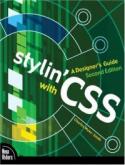 It’s hard to believe it’s been over three years since I wrote
the first edition of Stylin’ with CSS. In the intervening time, I have
been involved in the development of numerous Web sites and have fi
ne-tuned the way I use CSS in the process. I intended to make a few
small adjustments to this book for the second edition to cover IE7 and
generally bring it up to date, but I ended up making numerous
improvements to the fi rst three chapters and completely rewriting the
rest of the book. What should have taken weeks took almost a year.
It’s hard to believe it’s been over three years since I wrote
the first edition of Stylin’ with CSS. In the intervening time, I have
been involved in the development of numerous Web sites and have fi
ne-tuned the way I use CSS in the process. I intended to make a few
small adjustments to this book for the second edition to cover IE7 and
generally bring it up to date, but I ended up making numerous
improvements to the fi rst three chapters and completely rewriting the
rest of the book. What should have taken weeks took almost a year.The changes I have made refl ect the inevitable improvement to the skills of anyone who works constantly with CSS, and these changes also more deeply address two skills that all programmers need to master: to avoid rewriting code that they have previously written elsewhere, and to learn to write code in the most economical way possible. Ways in which you can achieve these two worthy goals in your own work are presented throughout this new edition of the book.
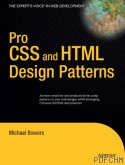 his is a solutions book for styling HTML 4.01 and XHTML 1.1 with CSS
2.1. It contains more than 350 design patterns you can put to use right
away. Each design pattern is modular and customizable, and you can
combine patterns to create an unlimited number of designs.
his is a solutions book for styling HTML 4.01 and XHTML 1.1 with CSS
2.1. It contains more than 350 design patterns you can put to use right
away. Each design pattern is modular and customizable, and you can
combine patterns to create an unlimited number of designs.Each design pattern has been thoroughly tested and proven to work in all major web browsers including Internet Explorer 7, Internet Explorer 6, Firefox 2, Opera 9, and Safari 2. All the content in this book is usable and practical. You won’t waste time reading about things that don’t work! With this book, you will no longer have to use hacks, tricks, endless testing, and constant tweaking in multiple browsers to get something to work.
Using a design pattern is as easy as copying and pasting it into your code and tweaking a few values. This book shows you which values you can modify and how they affect the result so you can create the exact style and layout you want—without worrying whether it will work.
This is more than a cookbook. It systematically covers every usable feature of CSS and combines these features with HTML to create reusable patterns. Each pattern has an intuitive name to make it easy to find, remember, and talk about. Accessibility and best practices are carefully engineered into each design pattern, example, and source code.
You can read straight through the book, use it as a reference, and use it to find solutions. You’ll love how the book’s consistent layout makes it a joy to use.
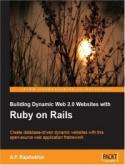 Ruby on Rails is an open-source web application framework
ideally suited to building business applications, accelerating and
simplifying the creation of database-driven websites. It has been
developed on the Ruby platform.
Ruby on Rails is an open-source web application framework
ideally suited to building business applications, accelerating and
simplifying the creation of database-driven websites. It has been
developed on the Ruby platform.This book is a tutorial for creating a complete website with Ruby on Rails (RoR). It will teach you to develop database-backed web applications according to the Model-View-Controller pattern. It will take you on a joy ride right from installation to a complete dynamic website. All the applications discussed in this book will help you add exciting features to your website. This book will show you how to assemble RoR's features and leverage its power to design, develop, and deploy a fully featured website.
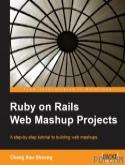 A web mashup is a new type of web application that uses data and
services from one or more external sources to build entirely new and
different web applications. Web mashups usually mash up data and
services that are available on the Internet—freely, commercially, or
through other partnership agreements. The external sources that a
mashup uses are known as mashup APIs.
A web mashup is a new type of web application that uses data and
services from one or more external sources to build entirely new and
different web applications. Web mashups usually mash up data and
services that are available on the Internet—freely, commercially, or
through other partnership agreements. The external sources that a
mashup uses are known as mashup APIs.This book shows you how to write web mashups using Ruby on Rails—the new web application development framework. The book has seven real-world projects—the format of each project is similar, with a statement of the project, discussion of the main protocols involved, an overview of the API, and then complete code for building the project. You will be led methodically through concrete steps to build the mashup, with asides to explain the theory behind the code.
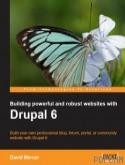 his book updates the bestselling Drupal: Creating Blogs, Forums,
Portals, and Community Websites for Drupal 6, the latest, much improved
version of this popular open-source Content Management System.
Targeting readers with little experience in website design, unfamiliar
with PHP, MySQL or HTML, and with little to no experience of Drupal, it
looks pragmatically at the steps needed from knowing you want a website
right through to designing and building it like a pro, and then
successfully managing and maintaining it. Experienced author David
Mercer uses a friendly, engaging style that is clear and concise,
allowing readers to advance rapidly until they can tackle any problem
with confidence. Drupal is an elegantly designed, well-supported and
flexible open-source CMS platform that empowers anyone to create a
website or blog and is rapidly becoming first choice of people in the
know. With this powerful tool you need not pay professionals to design
a site; you can do the job yourself.
his book updates the bestselling Drupal: Creating Blogs, Forums,
Portals, and Community Websites for Drupal 6, the latest, much improved
version of this popular open-source Content Management System.
Targeting readers with little experience in website design, unfamiliar
with PHP, MySQL or HTML, and with little to no experience of Drupal, it
looks pragmatically at the steps needed from knowing you want a website
right through to designing and building it like a pro, and then
successfully managing and maintaining it. Experienced author David
Mercer uses a friendly, engaging style that is clear and concise,
allowing readers to advance rapidly until they can tackle any problem
with confidence. Drupal is an elegantly designed, well-supported and
flexible open-source CMS platform that empowers anyone to create a
website or blog and is rapidly becoming first choice of people in the
know. With this powerful tool you need not pay professionals to design
a site; you can do the job yourself.
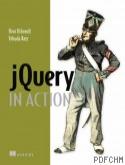 A good web development framework anticipates what you need to do and
makes those tasks easier and more efficient; jQuery practically reads
your mind. Developers of every stripe-hobbyists and professionals
alike-fall in love with jQuery the minute they've reduced 20 lines of
clunky JavaScript into three lines of elegant, readable code. This new,
concise JavaScript library radically simplifies how you traverse HTML
documents, handle events, perform animations, and add Ajax interactions
to your web pages.
A good web development framework anticipates what you need to do and
makes those tasks easier and more efficient; jQuery practically reads
your mind. Developers of every stripe-hobbyists and professionals
alike-fall in love with jQuery the minute they've reduced 20 lines of
clunky JavaScript into three lines of elegant, readable code. This new,
concise JavaScript library radically simplifies how you traverse HTML
documents, handle events, perform animations, and add Ajax interactions
to your web pages.
jQuery in Action, like jQuery itself, is a concise tool designed to make you a more efficient and effective web developer. In a short 300 pages, this book introduces you to the jQuery programming model and guides you through the major features and techniques you'll need to be productive immediately. The book anchors each new concept in the tasks you'll tackle in day-to-day web development and offers unique lab pages where you immediately put your jQuery knowledge to work.
There are dozens of JavaScript libraries available now, with major companies like Google, Yahoo and AOL open-sourcing their in-house tools. This book shows you how jQuery stacks up against other libraries and helps you navigate interaction with other tools and frameworks.
jQuery in Action offers a rich investigation of the up-and-coming jQuery library for client-side JavaScript. This book covers all major features and capabilities in a manner focused on getting the reader up and running with jQuery from the very first sections. Web Developers reading this book will gain a deep understanding of how to use jQuery to simplify their pages and lives, as well as learn the philosophy behind writing jQuery-enhanced pages.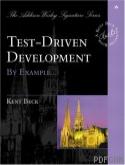
Clean code that works - now. This is the seeming contradiction that lies behind much of the pain of programming. Test-driven development replies to this contradiction with a paradox-test the program before you write it.
A new idea? Not at all. Since the dawn of computing, programmers have been specifying the inputs and outputs before programming precisely. Test-driven development takes this age-old idea, mixes it with modern languages and programming environments, and cooks up a tasty stew guaranteed to satisfy your appetite for clean code that works-now.
Developers face complex programming challenges every day, yet they are not always readily prepared to determine the best solution. More often than not, such difficult projects generate a great deal of stress and bad code. To garner the strength and courage needed to surmount seemingly Herculean tasks, programmers should look to test-driven development (TDD), a proven set of techniques that encourage simple designs and test suites that inspire confidence.
By driving development with automated tests and then eliminating duplication, any developer can write reliable, bug-free code no matter what its level of complexity. Moreover, TDD encourages programmers to learn quickly, communicate more clearly, and seek out constructive feedback.
Readers will learn to:
-
Solve complicated tasks, beginning with the simple and proceeding to the more complex.
-
Write automated tests before coding.
-
Grow a design organically by refactoring to add design decisions one at a time.
-
Create tests for more complicated logic, including reflection and exceptions.
-
Use patterns to decide what tests to write.
-
Create tests using xUnit, the architecture at the heart of many programmer-oriented testing tools.
This book follows two TDD projects from start to finish, illustrating techniques programmers can use to easily and dramatically increase the quality of their work. The examples are followed by references to the featured TDD patterns and refactorings. With its emphasis on agile methods and fast development strategies, Test-Driven Development is sure to inspire readers to embrace these under-utilized but powerful techniques.
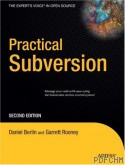
Practical Subversion, Second Edition draws on the experience of its authors, Daniel Berlin and Garrett Rooneyboth Subversion project membersto guide you through a complete introduction to this popular code management solution. And this edition has been updated to reflect the most recent changes to the popular Subversion version control system. After a crash course on Subversions key features, including a theme project that youre encouraged to follow, youll explore best practices, migration tips for moving from other versioning solutions, Subversion integration, and an overview of the Subversion APIs.
Effective developers and system administrators alike understand that their success is related to their ability to manage the dozens, sometimes hundreds, of files that they come into contact with on a regular basis. This file management includes determining a files changes over time, accommodating simultaneous edits by multiple users, and even reverting a file to an earlier version if a mistake or deletion has been made. Capitalizing on such capabilities requires a version control system like Subversion. Youll want to pick up a copy of this book because it is
- The most up-to-date book on the popular Subversion version control system
- Authored by two Subversion project contributors
- More than a mere introduction, covering best practices, migration issues, and more effective versioning through tool integration
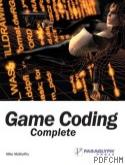 Expertly presents, from start to finish, the process of programming
commercially viable computer games! This is the kind of book that you
won't let out of our sight. From page one, Mike McShaffry, a leading
programmer for Origin Systems (Makers of Wing Commander and the Ultima
series) and Microsoft (Bicycle Casino), shows you how to create and
code the very best interactive games. With dozens of tips and code
illustrations, plus extensive narration of critical non-code issues,
Game Coding Complete is the guide to orchestrating bug-free,
high-quality game code that passes the muster of leading publishers
such as Electronic Arts and Microsoft. The book covers all critical
facets of programming, working with teams, selecting the right game
architecture, testing and debugging, scheduling, and more. The book
includes hundreds of insider tricks and techniques used by programmers
who learned their craft on cutting edge titles such as Ultima Online.
The C++ language is used throughout to explain specific programming
concepts. This book is destined to become a classic for all game
programmers. Foreword by game industry icon Warren Spector.
Expertly presents, from start to finish, the process of programming
commercially viable computer games! This is the kind of book that you
won't let out of our sight. From page one, Mike McShaffry, a leading
programmer for Origin Systems (Makers of Wing Commander and the Ultima
series) and Microsoft (Bicycle Casino), shows you how to create and
code the very best interactive games. With dozens of tips and code
illustrations, plus extensive narration of critical non-code issues,
Game Coding Complete is the guide to orchestrating bug-free,
high-quality game code that passes the muster of leading publishers
such as Electronic Arts and Microsoft. The book covers all critical
facets of programming, working with teams, selecting the right game
architecture, testing and debugging, scheduling, and more. The book
includes hundreds of insider tricks and techniques used by programmers
who learned their craft on cutting edge titles such as Ultima Online.
The C++ language is used throughout to explain specific programming
concepts. This book is destined to become a classic for all game
programmers. Foreword by game industry icon Warren Spector.
In this book you will learn:
* The nuts and bolts of the game coding process
* Insider techniques for writing top-notch game code
* 2D and 3D graphics techniques used by professional game developers
* Unique insight on critical algorithms you can't live without, debugging secrets, and tips for managing critical projects
* Key "gotchas" to avoid that can really hurt game development projects
With dozens of tips and code illustrations, plus extensive narration of critical non-code issues, Game Coding Complete is the guide to orchestrating bug-free, high-quality game code that will pass muster with leading game publishers such as Electronic Arts and Microsoft. This book covers all critical facets of game programming, working with teams, selecting the right game architecture, code optimization, and more.
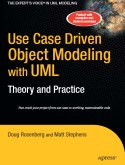 Use Case Driven Object Modeling with UML&Theory and Practice
shows how to drive an object-oriented software design from use case all
the way through coding and testing, based on the minimalist, UML-based
ICONIX process. In addition to a comprehensive explanation of the
foundations of the approach, the book makes extensive use of examples
and provides exercises at the back of each chapter.
Use Case Driven Object Modeling with UML&Theory and Practice
shows how to drive an object-oriented software design from use case all
the way through coding and testing, based on the minimalist, UML-based
ICONIX process. In addition to a comprehensive explanation of the
foundations of the approach, the book makes extensive use of examples
and provides exercises at the back of each chapter.
This book leads by example. It demonstrates common analysis and design errors, shows how to detect and fix them, and suggests how to avoid making the same errors in the future. The book also encourages you to examine its UML examples and to search for specific errors. You'll get clues, then later receive the answers during "review sessions" toward the end of the book.
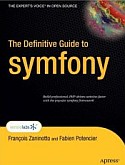 For this book, you need a basic understanding of PHP 5 and object-oriented programming. Of
For this book, you need a basic understanding of PHP 5 and object-oriented programming. Ofcourse, having already developed web applications in PHP before reading this book is a plus,
for you will see this book as a collection of answers to the questions you regularly ask yourself.
How This Book Is Structured
In this book, you will learn how to use symfony to build web applications. The chapters are
grouped into five parts:
• The Basics covers all the general concepts and prerequisites for starting symfony.
• The Core Architecture describes how the three layers of the Model-View-Controller (MVC)
architecture are implemented in symfony, and how to build pages and applications
according to this separation.
• Special Features explains how to use symfony’s mechanisms for shortening the development
of smart URLs, forms and validation, Ajax interactions, caching, and internationalized
applications.
• Development Tools covers the resources provided by symfony to make day-to-day
development tasks easier: code generators, unit testing framework, command-line
tasks, and plug-ins.
• Becoming a Symfony Expert reveals a few secret corners of the symfony code and shows
you how to tweak the framework’s behavior.
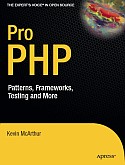 The book is organized into five parts:
The book is organized into five parts:Part 1, OOP and Patterns: This part provides a foundation for advanced OOP concepts. It dives right in and tells you all you need to know about abstract classes, interfaces, static methods, and patterns like the singleton and factory, as well as exceptions. The part concludes
with an introduction to the new features in PHP 6.
Part 2, Testing and Documentation: This part covers all those interesting “peripheral” concepts, like test-driven development and automated deployment. It teaches you about writing great documentation and includes introductions to several documentation standards, including PHPDoc and DocBook. You will find information about the reflection API and learn how to extract metadata from your programs. Finally, you’ll learn about continuous integration and how to use tools like Phing and Xinc to improve your development workflow.
Part 3, The Standard PHP Library (SPL): The SPL contains some of the most advanced PHP code ever written. It offers language support for advanced OOP concepts like indexers and iterators, and also provides structures for exceptions and patterns like observer/reporter. The information in this part will allow you to create much more elegant and well-formed classes than would normally be possible.
Part 4, The Model-View-Controller (MVC) Pattern: MVC is probably the most useful development pattern for PHP developers. It allows you to structure your applications and work in teams using the best resources to get the job done. A strong understanding of this pattern is probably the single most important job qualification for any PHP developer, so this book makes a special effort to fully explain it. This part of the book also introduces you to the
Zend Framework, an MVC-based framework embraced by thousands of PHP companies. It starts with a complete walk-through of how to get a framework application up and running, and then presents the core concepts and advanced features of the Zend Framework.
Part 5, Web 2.0: This part covers all the things you need to know about Web 2.0. You will find information about Ajax and JSON, SOAP web services, and SSL client authentication. This part includes a lot of really useful tutorials, based on personal experience.
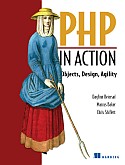 This book’s purpose involves a kind of bigamy. It introduces state-of-the art object oriented design principles, patterns, and techniques. Then it weds these to two different partners. The first partner is PHP, the programming language. The second partneris the PHP programmer’s everyday work. More specifically, this book is about handling and implementing these principles, patterns, and techniques in PHP with its specific syntax and characteristics. It is also about how to apply them to the specific and common challenges of web programming.
This book’s purpose involves a kind of bigamy. It introduces state-of-the art object oriented design principles, patterns, and techniques. Then it weds these to two different partners. The first partner is PHP, the programming language. The second partneris the PHP programmer’s everyday work. More specifically, this book is about handling and implementing these principles, patterns, and techniques in PHP with its specific syntax and characteristics. It is also about how to apply them to the specific and common challenges of web programming.Who should read this book?
This book is for programmers who develop applications in PHP and want to learn modern object-oriented practices, principles, and techniques, and how to apply them to the everyday challenges of web programming. It is not a beginner’s book in PHP; it presupposes a minimum of familiarity with PHP—or experience in other programming languages—and with the basic ideas and challenges of web programming.
How this book is organized
The book is divided into four parts. Parts 1 and 2 introduce the principles, patterns, and techniques mentioned initially and demonstrate how they can be implemented in PHP. Part 1 introduces and develops the subjects of object-oriented programming and design. Part 2 deals with unit testing and refactoring. Parts 3 and 4 apply the material from the first two parts to the everyday challenges of web programming. Part 3 is about the web interface, while part 4 deals with databases and data storage.
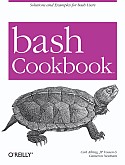 This book covers bash, the GNU Bourne Again Shell, which is a member of the Bourne family of shells that includes the original Bourne shell sh, the Korn shell ksh, and the Public Domain Korn Shell pdksh. While these and other shells such as dash, and zsh are not specifically covered, odds are that most of the scripts will work pretty well with them.
This book covers bash, the GNU Bourne Again Shell, which is a member of the Bourne family of shells that includes the original Bourne shell sh, the Korn shell ksh, and the Public Domain Korn Shell pdksh. While these and other shells such as dash, and zsh are not specifically covered, odds are that most of the scripts will work pretty well with them.You should be able to read this book cover to cover, and also just pick it up and read anything that catches your eye. But perhaps most importantly, we hope that when you have a question about how to do something or you need a hint, you will be able to easily find the right answer—or something close enough—and save time and effort.
A great part of the Unix philosophy is to build simple tools that do one thing well, then combine them as needed. This combination of tools is often accomplished via a shell script because these commands, called pipelines, can be long or difficult to remember and type. Where appropriate, we’ll cover the use of many of these tools in the context of the shell script as the glue that holds the pieces together to achieve the goal.
